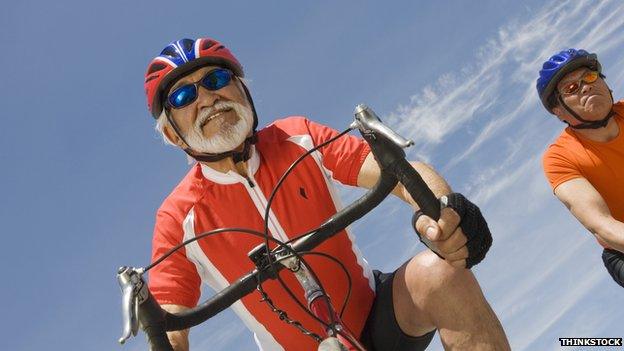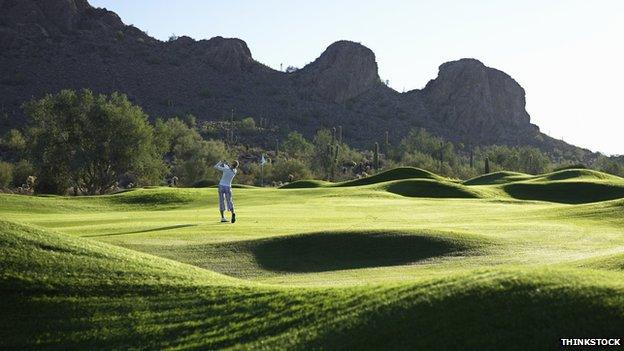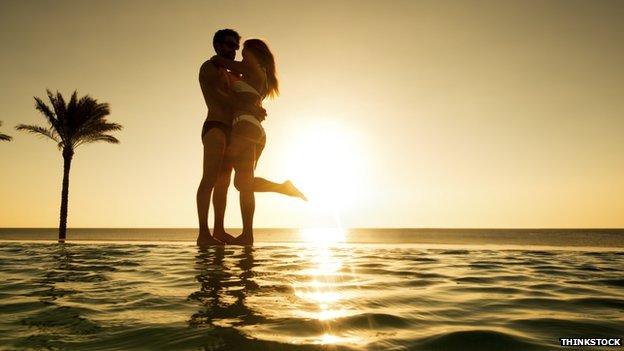Mamils, braggies and poshtels: tourism's future?
- Published

Looking down the railtracks of travel, the far horizons include Mamils, braggies and poshtels, as demographics, tight budgets and new tech disrupt the old, packaged ways.
Yes, it's November, so it must be about time to think about holidays. Isn't it always? Much of the industry gathers in London at this time of year, for the World Travel Market. And that's when Euromonitor publishes its annual travel trends.
Extrapolating from what's already happening, and projecting those trends ahead with a bit of tea-leaf reading thrown in, the worst that can be said of this is that it's a bit of fun.
The survey sees healthy signs in the global industry, even if growth is coming off the boil. Measured by tourism arrivals, the report sees growth slowing, after a 5% rise to 1.1 billion in 2013 - but it won't be slowing by much.
It's reckoned that the average household income at which people begin to afford a holiday is around US$20,000 (£12,500). And even with a global slowdown, a lot more people have been breaking through that threshold.
But it's clear from this year's trends that people are searching out value, and using ever cleverer technology to do it.
Cheap but chic
In Britain, the trend identified in this report is for the 'poshtel' - reinventing the youth hostel to make it more attractive to travellers young and old - notably including time-rich, cash-conscious, experience-seeking retirees.
That's often with a design makeover to give the hostel a bit of a boutique feel, or at least an en suite room, free wi-fi, maybe a modest breakfast, while driving as much cost out as possible.
With a starting rate around £12 per bed night, the aim is to "glamourise communal living" and provide something more authentic than soulless budget hotel rooms, for which prices are being lowered to compete.
If you know central Edinburgh or Inverness, you'll see the hostel business is already about a lot more than the Scottish Youth Hostel organisation. It's reckoned that the sector is growing at 3% per year up to 2018, meaning it could see 653 UK hostels, turning over £216m per year.
Men in Lycra
Travelling between your itinerary of poshtels is another challenge, and use of the bicycle is a trend that's been spotted by Euromonitor. It links this with the USA, where it sees a link with the decline in golf.

Tiger Woods helped the sport to 25 million US participants at the start of the century, but it's fallen to 19 million. And what is the golfing demographic taking up instead? That's right: peddling. So meet the 'Mamil': a middle aged man in lycra.
Golf may be picking up with travellers from recently emerged economies, such as China. But if the trend away from golfers travelling from traditional markets is right, it's one that the Scottish tourism industry might want to watch warily.
The recommendation is to provide for peddlers who are also looking for additional outdoor adventure, such as kayaking. Better cycle lanes and routes would be a nice idea too.
In Africa, the outdoor experience that's notable for its growth in this report is surfing. It's estimated there are already 35 million surfers worldwide, rising to 50 million within five years. And with a young demographic, they can be attracted to some great beaches, mostly in south-east and north-west Africa.
Peer-to-peer
Returning to the new tech end of tourism, with the search for value and authenticity, continental Europe is seeing a rise in pop-up eateries.
AirBnB has led the way on peer-to-peer accommodation, disrupting the market by helping people find cheap rooms in people's homes. Uber has been doing something similar with taxi bookings, to the fury of cabbies.
Now you'll get a similar sort of offer for food on eatwith.com and bookalokal. User reviews help to provide guidance on quality.
At the big corporate level, it's noted that restaurant reservation sites have been changing hands for a lot of dollars, including OpenTable and La Fourchette, bought by TripAdviser. They are doing well out of the boom in use of mobile and locational technology to find the best and best value.
And while the spend on food by travellers is on the rise across most of Europe, it's notable from the Euromonitor report how much more people are willing to spend in France, how little in Russia, while Germany seems to the only nation selected which is seeing a falling food spend. Could currywurst be to blame?
It's noted that online bookings last year accounted for 27% of tourism spend, and rising fast. By 2018, it's calculated that mobile tech bookings could be a third of online bookings.
Edinburgh-based Skyscanner has been tracking that growth, with the downloading of its app. The pattern it's been seeing is of people researching travel plans as they commute, then booking on a more conventional online link.
The big change in Indian travel, we're told this week, is a surging appetite for online booking of rail tickets - which seems to be a sad loss for those of us who have spent many contented hours studying sub-continental queuing techniques.
Brand Europe
European tourism is not in a very happy state, the World Travel Market has been hearing. Another report, published this week at the London event, highlights the challenge of retaining Europe's leading position as a tourist destination.
That said, the most recent figures make it look pretty healthy. Europe is reckoned to get 52% of those billion-plus worldwide arrivals, or 564 million to be more precise - many of them, of course, from within Europe.
The value of that is 42% of the world total. It accounts for 9% of European Union GDP, and 10% of its employment.
However, the growth rate has been slowing. While Greece and Cyprus have seen good growth recently, the frostiness of Europe's relations with Russia has been harming that market as a source of business. That won't help some top end hotels in Scotland, such as Gleneagles, where they have significant high-end Russian business.
The other problems besetting European tourism, according to the body set up to promote it, are complex regulatory controls, different and difficult visa demands (the UK has reportedly been losing out to France for that reason), air passenger tax (a particularly sore point in Scotland) and "lack of a clear brand image".
There may be those who wonder whether Europe could have, or needs, a clear brand image, when its tourism offer is so diverse, and with so many national brand images already well established.
Undaunted, and with European Commission funding, the industry body has set up its own website, visiteurope.com. It covers Turkey to Iceland, in a bid to ensure that it doesn't lose share of this growing market, as non-Europeans look to new horizons.
If you try the website, as I have, you may also find that it seems deliberately designed to discourage you from reading about individual countries, and how to find out more from and about them.
Holiday envy
Wherever you plan to travel, one constant about the experience is that everyone wants to tell the folk back home all about it - the better it is, the more they want to show off.

New tech is, of course, replacing the postcard. Within a few minutes of arriving at a new hotel, it's common to send your chums a photo of the room, the view or both, and even more common to post them on Facebook or through Instagram.
That's where the 'braggie' comes in - a version of the selfie, with the main aim of causing maximum envy.
We're told, in the Euromonitor report, that it's not just a social media fad. Because it's the authentic view of a real customer, it's very smart marketing. So clever hotels and tourism businesses are offering inducements to post your braggies online, such as free wi-fi or a session in the spa.